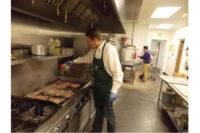Growth Opportunities | Restaurants
Opportunities exist in the foodservice industry
Restaurants and their suppliers are adapting to reduced in-person dining and increased take-out options.

The Coronavirus pandemic has hurt many businesses and affected many ways of life. Restaurants have been hit particularly hard, and the industry is still reeling from reduced capacity, closed dining rooms and the lingering uncertainty about how to avoid the virus.
A substantial number of restaurants closed down in March and never re-opened. Of those that are attempting to adjust to the new normal of the foodservice industry, their menus are not what they used to be. Those changes present opportunities to connect with new audiences, for both the restaurants and their meat suppliers.
“Steakhouses continue selling some steaks, but they are selling more burgers, because they hold up better for carryout,” said Sara Scott, vice president of foodservice for the Certified Angus Beef brand, Wooster, Ohio. “More restaurants are also selling family meal packages, like raw steaks with cooking instructions and sides for a Father’s Day or July 4th barbecue. They’re getting more creative in packaging and offering family-style options, too.”
One way steakhouses have become more efficient is to use the same cut of steak for multiple menu items. Scott says that the same cut of steak can be sliced for a sandwich, braised and shredded for tacos, or cut into kabobs for an appetizer or a steak salad.
Nelson Castillo, managing partner of Prime Cincinnati, Street City Pub and AT580 Market Gourmet, all in downtown Cincinnati, says he was fortunate enough to have a to-go market in the lobby level of his building.
“My wife and our staff installed an online ordering system on Sunday [Ohio shut down sit-down restaurants on Sunday, March 15] and we were open on Monday. We did incredible those first few weeks because everyone else was closed down,” he says.
Castillo says that the company’s Certified Angus Beef prime steaks continue to be the most popular items. His steakhouse offers a filet and a New York strip. He adds that his Jack burger has been popular ever since he moved it to the appetizer portion of the menu. The burger is now cut in pieces and sold as “Jack Bites.”
“Basically, we’ve made it so people can share a burger as an appetizer. People love it,” Castillo says.
Prime’s menu has changed as a result of the pandemic. Seafood offerings are greatly reduced, as those suppliers continue to try and get back on their feet. Castillo says that company’s online menu is quite different from its dine-in menu.
“The online menu is more based around folks traveling and items that travel well,” he explains. “Our dine-in menu has more dry-aged items, and we’ve created a prix fixe menu with appetizers, a salad, main and a dessert.”
Along with working with restaurants to find a successful mix of products, restaurant suppliers are turning to alternate markets. Purely Meat Co., located in Chicago, quickly entered into the direct-to-consumer business. President and owner Maribel Musillami switched the company’s business model without having to cut staff.
“Our goal is to expand this channel of our business, including more grassroots, community-based efforts,” said her husband, Joe Musillami. “Our hand-cut steaks and chops are unique offerings for consumers in our market.”
As restaurants re-open, Purely Meat is ready to serve the needs of their clients. Joe Musillami believes that diners will go back to the traditional cuts, as they can create a sense of normalcy.
“We are blessed to have amazing relationships with our customers. There’s a human side to the business, and we take pride in it,” he adds. “We’ve done our best to stay in touch with the restaurant community as a whole. Our team has been reaching out to long-time and new customers throughout the pandemic to ensure they are equipped to move forward.”
Along with offering the time-tested, traditional cuts, Purely Meat has been showing restaurants different ways to cut meats and introducing them to alternative cuts.
“On top of that, we’ve done our best to help them with the business side of their operations,” adds Musillami. “As a Hispanic female-owned company, working together is part of our foundation.” IP
Looking for a reprint of this article?
From high-res PDFs to custom plaques, order your copy today!






